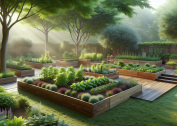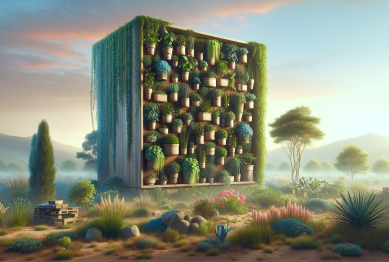Explore clever ways to enhance your outdoor living area with innovative garden upgrades. This guide uncovers practical landscaping ideas, sustainable gardening tips, and fresh design inspiration to help you create a welcoming and beautiful retreat right at home.
Embracing Smart Landscaping for Every Size Yard
Smart landscaping is about more than looks—it’s about blending aesthetics with functionality. The right choices can boost curb appeal and maximize how a yard is used. Raised garden beds, winding paths, and perennial borders are just a few creative options that offer both beauty and structure. Homeowners often find that defining spaces, whether for herb gardens or relaxation zones, helps them feel more connected to their landscape. Incorporating ornamental grasses or ground cover plants can provide low-maintenance texture while reducing the need for traditional lawn care. These small landscaping changes are surprisingly transformative and adaptable to both tiny patches and sprawling yards.
For those wanting a more sustainable approach, xeriscaping is gaining traction. Xeriscaping uses drought-tolerant plants and mulches to minimize water use, which is especially valuable in regions that face dry spells or water restrictions. Succulents, sage, and lavender thrive with minimal irrigation, making them suitable options for eco-conscious gardens. Strategic placement of rocks and mulch not only conserves moisture but also suppresses weeds. Many find that after upgrading to a drought-smart garden, maintenance becomes easier, costs drop, and the outdoor space thrives year-round. These changes make gardens resilient and environmentally friendly.
Layering your garden design can introduce more visual interest. Consider plant heights and bloom times to ensure the garden always has something appealing to look at. Trees give shade and anchor the yard; shrubs offer structural support; and annuals or bulbs add pops of color throughout the seasons. Paths, patios, and seating areas naturally lead people to explore and enjoy the landscape. Smart layout changes like these can make even a modest plot feel spacious. By intentionally varying textures, heights, and greenery, gardens gain a dynamic appearance that transforms the entire home environment.
Outdoor Lighting Ideas for Warm Evenings
Outdoor lighting transforms a garden after dark, offering safety and ambiance. String lights draped through trees or overhead create a soft, magical effect perfect for gatherings or peaceful evenings outside. Solar-powered garden lights along walkways make paths easy to navigate while reducing energy bills. These simple additions balance functionality with style and help extend outdoor enjoyment well after sunset. Many homeowners note that outdoor lighting is one of the most cost-effective upgrades for increasing a yard’s usability and charm.
Accent lighting highlights favorite features like flower beds, sculptures, or water elements. Spotlights or uplights can draw attention to architectural plants or beautiful stone walls, elevating how the garden feels at night. Adjustable fixtures allow for easy changes throughout the year, keeping the look fresh. By illuminating focal points, homeowners can set a mood or guide the eye to special spots. This technique creates a tranquil and inviting atmosphere that adds depth and dimension after dusk.
Choosing the right light temperature also matters—warm white lights are soothing while cool-toned lights may feel harsh in a natural setting. For a whimsical touch, lanterns, fairy lights, or stake lights shaped like flowers can add personality. Solar-powered, battery-operated, or low-voltage lights are eco-friendly options. Outdoor-rated fixtures ensure safety and durability. Investing in lighting solutions brings out the best in a garden space and allows for safe, enjoyable evenings outdoors all season long.
Sustainable Gardening Tips for Healthy Yards
Sustainable gardening practices keep landscapes vibrant and minimize harm to the environment. Composting kitchen scraps and garden waste reduces landfill use and enriches the soil naturally. Homegrown compost provides nutrients for plants, supporting healthy growth without synthetic fertilizer. Lawn alternatives, such as clover or native ground covers, decrease the need for watering, mowing, and chemical treatments. These small shifts contribute to a more resilient garden capable of withstanding changing weather patterns.
Mulching is another eco-friendly technique that offers multiple benefits. Mulch conserves moisture, suppresses weeds, and moderates soil temperature across the seasons. Organic mulches—like shredded bark, straw, or leaf litter—improve soil structure as they decompose. Placing mulch around trees, shrubs, and flower beds ensures healthier plants and less manual labor throughout the growing season. Transitioning to mulched beds is an effective way to polish the look of a garden while prioritizing its long-term health.
Creating habitats for pollinators is vital for a thriving ecosystem. Integrating flowering plants like bee balm, zinnias, or native wildflowers supports bees, butterflies, and hummingbirds. Avoiding pesticides and selecting a diversity of blooms helps boost wildlife populations. Small touches, such as birdbaths or insect hotels, invite nature closer and foster biodiversity. These sustainable choices make the garden a haven for people and wildlife alike, increasing joy and balance throughout the space.
Creative Container Gardening for Versatile Spaces
Container gardening is ideal for maximizing plants when space is limited or soil is poor. Pots, window boxes, and vertical planters offer flexibility to decorate patios, balconies, or doorsteps with greenery. Mixing herbs, vegetables, and flowers in containers makes for vibrant mini-gardens that are easy to rearrange seasonally. Self-watering planters or recycled containers can extend the growing season with less effort. Even renters can join in—containers make gardening accessible for everyone, regardless of space or experience level.
Choosing the right soil, fertilizers, and plant varieties makes a big difference in success. Potting mixes designed for container plants offer drainage and nutrient support. Slow-release fertilizers or organic compost ensure steady growth. Compact or dwarf plant varieties thrive in confined spaces, while trailing vines can cascade over the edges for lush effect. Sun-loving annuals like petunias or marigolds mix well with edible crops like tomatoes or peppers, creating a practical and pretty edible arrangement.
Containers can also be used for specialty gardens—such as kitchen herb gardens, butterfly-attracting arrangements, or bulb gardens for spring color. Seasonal swapping keeps interest high; for example, spring tulips can be exchanged for summer geraniums or autumn chrysanthemums. With a little planning, container gardening allows everyone to customize their home’s look and bring new life to decks and porches. Experimenting with different shapes and heights adds depth and flair, making container gardens endlessly adaptable.
Low-Maintenance Solutions for Lasting Beauty
Low-maintenance gardens are designed to stay attractive with minimal intervention. Selecting hardy perennials, evergreen shrubs, and drought-tolerant plants reduces daily care needs. Drip irrigation systems or soaker hoses maintain consistent watering without waste or hassle. Mulching pathways and using stepping stones minimizes muddy spots and controls weeds. These features free up time to enjoy the garden rather than tending to chores. For busy individuals, low-maintenance strategies ensure yards are always inviting without becoming overwhelming.
Edging flower beds with stone or metal provides defined lines and prevents invasive grass from creeping in. Installing ground cover plants between pavers keeps weeds away and adds green accents. Planting in groups of three or more helps fill beds quickly, creating a lush look without constant replanting. Routine pruning of shrubs and cutting back perennials in late fall keeps growth tidy and healthy. Automation tools, like programmable sprinklers, offer even more convenience for those seeking reliable upkeep over time.
Low-maintenance does not mean sacrificing visual appeal. Ornamental grasses, sedums, and coreopsis provide year-round interest with minimal fuss. Features like rain gardens or gravel patios manage excess water and add texture. Thoughtful plant selection and a few durable hardscape upgrades can yield outdoor spaces that remain vibrant and welcoming through all seasons. Adopting these strategies helps ensure a beautiful yard for years to come without ongoing stress.
Designing Outdoor Living Rooms for Relaxation
Turning a section of the garden into an outdoor living room greatly increases the enjoyment of home life. Weather-resistant furniture, outdoor rugs, and throw pillows can quickly define a seating zone. By grouping furniture under a pergola, umbrella, or simple shade sail, the space becomes perfect for lounging, reading, or even al fresco meals. Adding a small fire pit or chiminea creates warmth for chilly evenings, making the outdoors cozy and inviting all year long. This approach invites families and friends to gather outside, extending the use of the garden well beyond the growing season.
Flexibility in furnishings allows for easy adaptation. Foldable tables, stackable chairs, and modular loungers accommodate both quiet retreats and social occasions. Lightweight, weatherproof options can be rearranged depending on need, while outdoor storage boxes protect cushions and garden games. Decorative touches like LED lanterns, wind chimes, or water fountains enhance the sense of comfort and set a relaxing mood. Personalizing with colorful planters and artwork infuses unique character into the outdoor living room.
Incorporating shade and privacy elements helps create an oasis feel. Trellises clad in climbing vines, tall container plants, or even recycled pallet partitions can shield the space from neighbors or midday sun. Ample shade and quiet corners encourage reading, napping, or mindful relaxation. Combining comfort, beauty, and practical features fosters a true indoor-outdoor lifestyle—making every garden an extension of the home’s living space.
References
1. U.S. Environmental Protection Agency. (n.d.). Water-Efficient Landscaping. Retrieved from https://www.epa.gov/watersense/water-efficient-landscaping
2. Royal Horticultural Society. (n.d.). Sustainable gardening. Retrieved from https://www.rhs.org.uk/science/conservation-sustainability/sustainable-gardening
3. Better Homes & Gardens. (n.d.). Container Gardening Basics. Retrieved from https://www.bhg.com/gardening/container/plans-ideas/container-gardening-basics/
4. The Spruce. (n.d.). How to Install Outdoor Lighting. Retrieved from https://www.thespruce.com/outdoor-lighting-ideas-4138165
5. National Wildlife Federation. (n.d.). Creating a Pollinator-Friendly Yard. Retrieved from https://www.nwf.org/Garden-for-Wildlife/About/National-Initiative/Pollinators
6. University of Minnesota Extension. (n.d.). Low-maintenance landscaping. Retrieved from https://extension.umn.edu/lawns-and-landscapes/low-maintenance-landscaping









